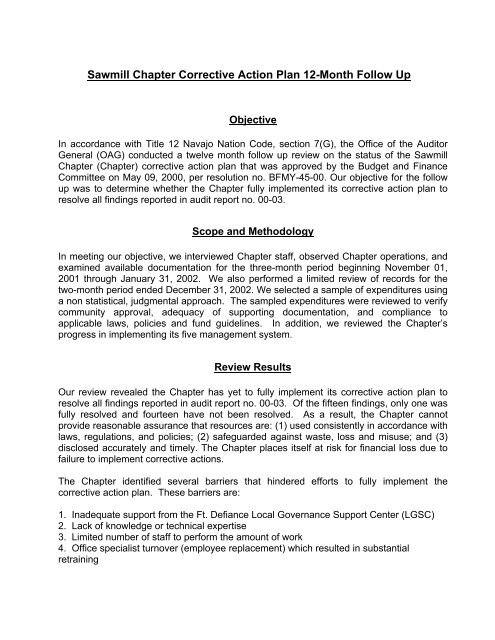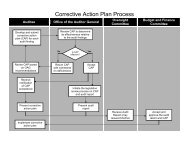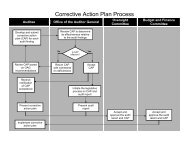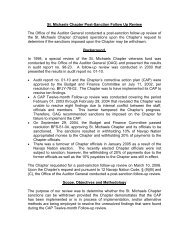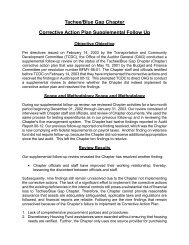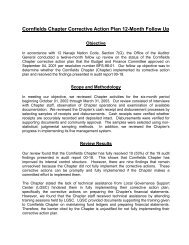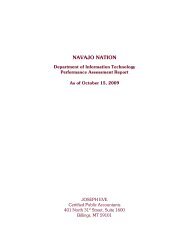Sawmill Chapter Corrective Action Plan 12-Month Follow Up
Sawmill Chapter Corrective Action Plan 12-Month Follow Up
Sawmill Chapter Corrective Action Plan 12-Month Follow Up
You also want an ePaper? Increase the reach of your titles
YUMPU automatically turns print PDFs into web optimized ePapers that Google loves.
<strong>Sawmill</strong> <strong>Chapter</strong> <strong>Corrective</strong> <strong>Action</strong> <strong>Plan</strong> <strong>12</strong>-<strong>Month</strong> <strong>Follow</strong> <strong>Up</strong><br />
Objective<br />
In accordance with Title <strong>12</strong> Navajo Nation Code, section 7(G), the Office of the Auditor<br />
General (OAG) conducted a twelve month follow up review on the status of the <strong>Sawmill</strong><br />
<strong>Chapter</strong> (<strong>Chapter</strong>) corrective action plan that was approved by the Budget and Finance<br />
Committee on May 09, 2000, per resolution no. BFMY-45-00. Our objective for the follow<br />
up was to determine whether the <strong>Chapter</strong> fully implemented its corrective action plan to<br />
resolve all findings reported in audit report no. 00-03.<br />
Scope and Methodology<br />
In meeting our objective, we interviewed <strong>Chapter</strong> staff, observed <strong>Chapter</strong> operations, and<br />
examined available documentation for the three-month period beginning November 01,<br />
2001 through January 31, 2002. We also performed a limited review of records for the<br />
two-month period ended December 31, 2002. We selected a sample of expenditures using<br />
a non statistical, judgmental approach. The sampled expenditures were reviewed to verify<br />
community approval, adequacy of supporting documentation, and compliance to<br />
applicable laws, policies and fund guidelines. In addition, we reviewed the <strong>Chapter</strong>’s<br />
progress in implementing its five management system.<br />
Review Results<br />
Our review revealed the <strong>Chapter</strong> has yet to fully implement its corrective action plan to<br />
resolve all findings reported in audit report no. 00-03. Of the fifteen findings, only one was<br />
fully resolved and fourteen have not been resolved. As a result, the <strong>Chapter</strong> cannot<br />
provide reasonable assurance that resources are: (1) used consistently in accordance with<br />
laws, regulations, and policies; (2) safeguarded against waste, loss and misuse; and (3)<br />
disclosed accurately and timely. The <strong>Chapter</strong> places itself at risk for financial loss due to<br />
failure to implement corrective actions.<br />
The <strong>Chapter</strong> identified several barriers that hindered efforts to fully implement the<br />
corrective action plan. These barriers are:<br />
1. Inadequate support from the Ft. Defiance Local Governance Support Center (LGSC)<br />
2. Lack of knowledge or technical expertise<br />
3. Limited number of staff to perform the amount of work<br />
4. Office specialist turnover (employee replacement) which resulted in substantial<br />
retraining
With the exception of inadequate support from LGSC, the identified barriers are unjustified<br />
for the <strong>Chapter</strong>’s lack of performance in implementing corrective actions. Further, the<br />
<strong>Chapter</strong> had ample time to fully implement the corrective action plan. Since the Budget<br />
and Finance Committee approved the <strong>Chapter</strong>’s corrective action plan in May 2000, the<br />
<strong>Chapter</strong> had more than two and a half years to implement corrective actions and resolve<br />
the findings prior to OAG’s follow up review.<br />
Inadequate support from LGSC. The community services coordinator (CSC) stated he<br />
contacted LGSC for technical assistance, but LGSC did not respond to his requests. This<br />
contributed to the <strong>Chapter</strong>’s non-implementation of the corrective action plan. During our<br />
review, LGSC did not provide any evidence of technical assistance to <strong>Sawmill</strong> <strong>Chapter</strong>.<br />
Therefore, the lack of support from LGSC is a contributing factor for the <strong>Chapter</strong>’s failure<br />
to fully implement its corrective action plan.<br />
Lack of technical knowledge or expertise. <strong>Chapter</strong> staff stated they lacked the technical<br />
knowledge to implement the corrective action plan. However, a majority of the corrective<br />
actions outlined in the <strong>Chapter</strong>’s corrective action plan are simple tasks that do not require<br />
vast technical expertise to implement. The CSC previously held a managerial position<br />
prior to employment with the <strong>Chapter</strong> beginning in 1996. Therefore, the <strong>Chapter</strong> staff’s<br />
claim of not possessing the technical knowledge to implement the corrective action plan is<br />
unacceptable.<br />
Limited number of staff. Observation and review of <strong>Chapter</strong> records revealed staff was<br />
inefficient in performing their job. This inefficiency unnecessarily increases their workload.<br />
An example of inefficiency is the maintaining of both manual and computerized accounting<br />
records, such as the maintaining of two check registers. This is duplication of work that is<br />
time-consuming and unnecessary. To lessen their workload, the staff should avoid<br />
maintaining duplicate accounting records.<br />
Staff turnover. The office specialist was replaced in October 2001. According to the CSC,<br />
the individual most recently hired did not possess all the required skills and knowledge.<br />
As a result, substantial training was provided. However, this position requires performing<br />
uncomplicated routine duties so that substantial training is unwarranted.<br />
Conclusion<br />
Most of the audit findings have yet to be resolved because the corrective action plan was<br />
not fully implemented. The underlying cause is nonperformance of duties by the <strong>Chapter</strong><br />
officials, CSC, and Ft. Defiance LGSC.<br />
Our follow up review did not find any indication of adequate oversight by the <strong>Chapter</strong><br />
officials to ensure successful implementation of the corrective action plan. The <strong>Chapter</strong><br />
officials have oversight duties over <strong>Chapter</strong> staff and operations; therefore, they should be<br />
monitoring staff and operations, to ensure the corrective action plan is successfully<br />
implemented. OAG, thus, recommends <strong>Sawmill</strong> <strong>Chapter</strong> and its officials be sanctioned for<br />
failure to implement the corrective action plan, in accordance with Title <strong>12</strong> Navajo Nation<br />
Code, sections 9(B) and 9(C).
Ft. Defiance LGSC and the <strong>Chapter</strong> CSC are also accountable for the failure to implement<br />
the corrective action plan. LGSC’s duty is to assist the <strong>Chapter</strong> to implement any<br />
necessary corrective actions and the CSC has the duty of implementing the corrective<br />
action plan. However, these duties were not performed. Thus, nonperformance of duties<br />
by the LGSC and CSC contributed to failure in resolving all findings. Therefore, OAG<br />
recommends the Executive Director of the Division of Community Development to<br />
evaluate the LGSC’s lack of performance and take appropriate disciplinary actions.<br />
Likewise, the <strong>Chapter</strong> officials should evaluate the CSC’s lack of performance and take<br />
appropriate disciplinary action.


